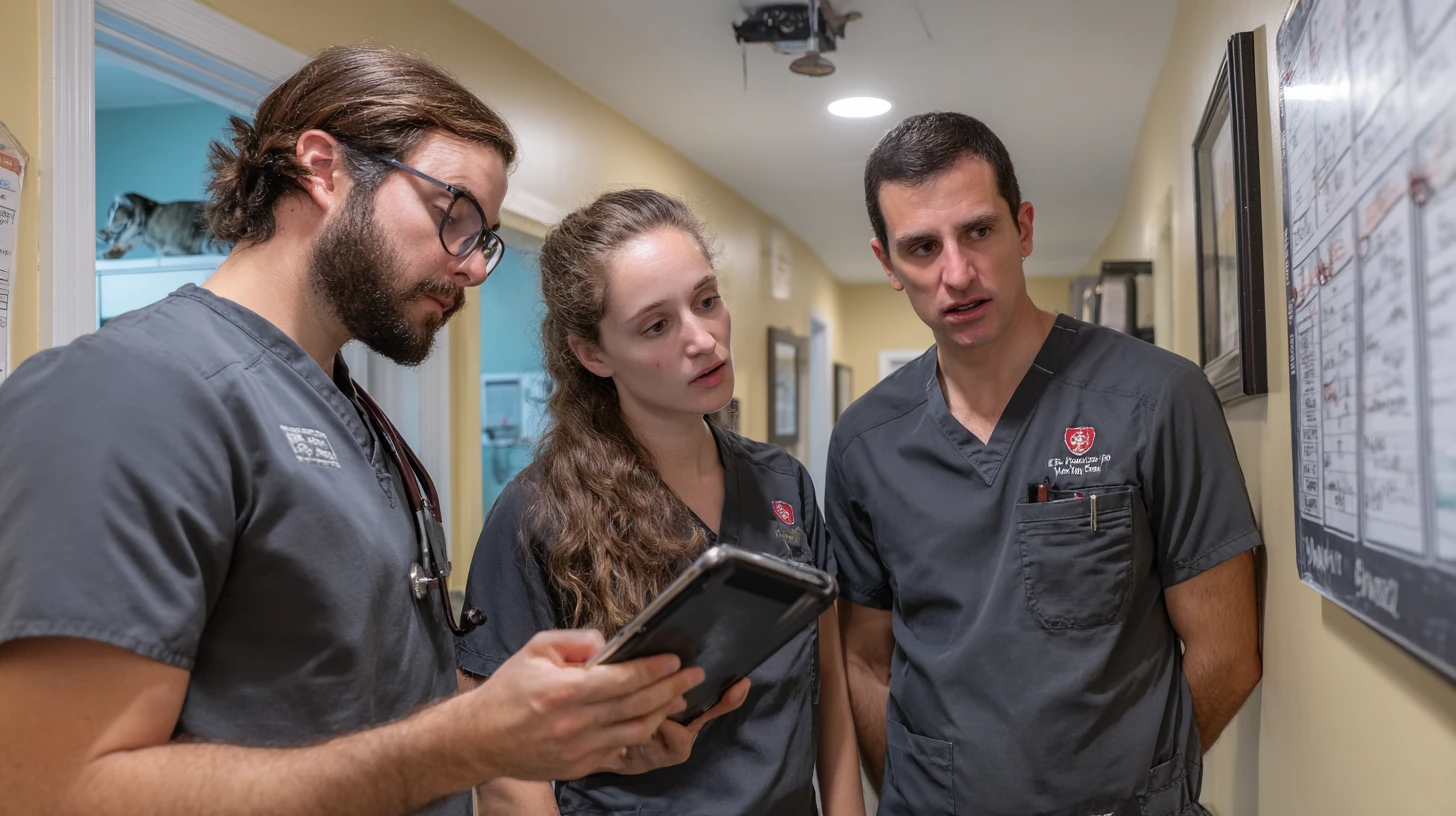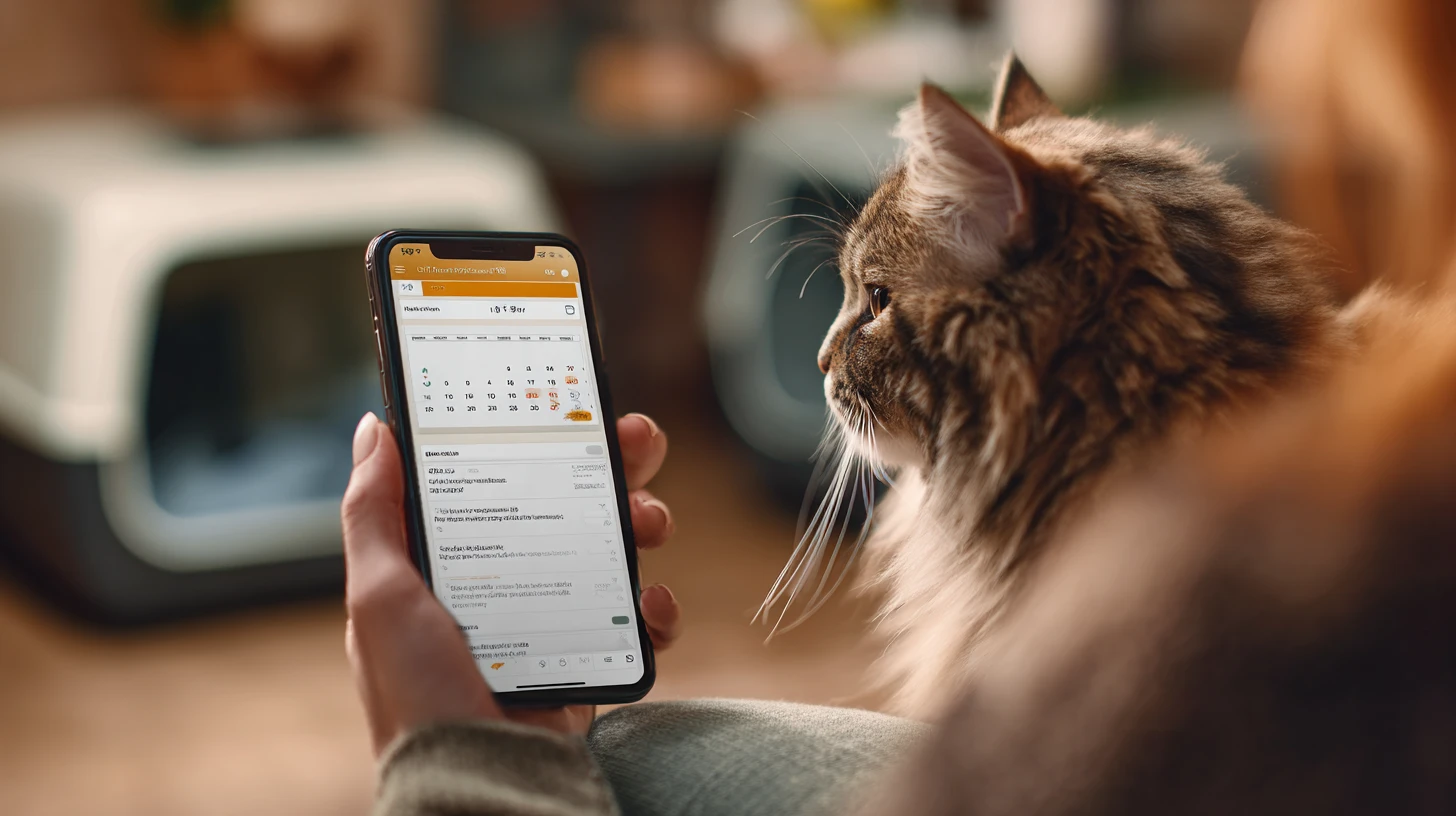Veterinary Scheduling Software That Actually Reduces No-Shows and Phone Load
Veterinary scheduling software can reduce no-shows by up to 30% and cut phone volume in half. Here's what actually works and how to set it up in week one.

Let's be honest about your schedule for a second. It probably feels more fragile than you'd like to admit. One unexpected surgery bumps everything, a few no-shows create holes you can't fill, and your CSRs are fielding the same "can I book an appointment" calls on repeat while emergencies wait on hold.
You're not imagining the chaos. And you're definitely not alone.

The numbers tell a frustrating story: a typical veterinary practice loses thousands of dollars per doctor each year to no-shows and late cancellations. Industry data consistently shows average no-show rates hovering around 10-11%, with some practices reporting even higher numbers. That's not just revenue walking out the door—it's clinical capacity you could have used for patients who actually needed care.
Meanwhile, your phone system is strangling your front desk. Your team spends hours playing calendar Tetris with clients who could have booked themselves online at 10 PM. And every minute they spend on routine scheduling is a minute they can't spend on the complex cases that actually need human judgment. If you're exploring tools that can absorb those after-hours calls without adding more headcount, it’s worth looking at AI reception tools for veterinary practices as part of the same scheduling strategy.
Here's the good news: veterinary scheduling software can fix both problems, but only if you set it up to solve real outcomes instead of just looking pretty in a demo. If you want the full landscape of options before you decide, you can browse Appointment Scheduling software on VetSoftwareHub.
This guide will show you exactly what works, what to set up first, and how to measure whether it's actually helping your practice. For a deeper, step-by-step breakdown, see the veterinary scheduling software complete guide.
Why Most Practices Get Veterinary Scheduling Software Wrong
Walk into any veterinary conference and you'll see booth after booth promising "AI-powered scheduling" and "intelligent calendars." The demos look gorgeous. The features sound impressive. And six months after you sign the contract, your no-show rate hasn't budged and your phones are still ringing off the hook.
What happened?
Usually, it's this: you bought veterinary scheduling software for what it could do, not what you needed it to actually do. You got distracted by feature lists instead of focusing on measurable outcomes. If you want a simple way to keep vendor pitches grounded, the Vendor Interview Cheatsheet pairs well with this mindset.
Let me suggest a different approach.
Start With Two Simple Outcomes
Before you configure a single setting in your new veterinary scheduling software, commit to two specific, measurable goals for your first month:
-
Reduce no-shows and late cancellations
-
Reduce inbound scheduling calls
That's it. Everything else is noise until you nail these two.
Now pull some baseline numbers from last month:
-
Total appointments scheduled
-
No-shows plus late cancellations (combined)
-
Phone calls related to booking or rescheduling
You don't need a fancy analytics dashboard for this. A simple spreadsheet works fine. You just need a clean starting point so you can prove whether your changes are actually working.
Once you have your baseline, every feature you turn on should tie directly back to one of those two outcomes. If it doesn't clearly reduce no-shows or phone volume, leave it off for now.
What Actually Reduces No-Shows (And What Doesn't)
Let's talk about what moves the needle on missed appointments, because a lot of conventional wisdom here is wrong.
Two-Step Confirmations Beat Single Reminders Every Time
Sending one reminder the day before an appointment is better than nothing. But it's nowhere near as effective as a two-step confirmation process with an easy way for clients to respond.

The pattern that consistently works across veterinary practices:
-
Confirmation immediately at booking – "You're scheduled for Tuesday, April 15 at 2:30 PM. Mark your calendar."
-
Reminder 48 hours prior – "Your appointment is in 2 days. Tap to confirm or reschedule."
-
Same-day reminder for morning appointments – "See you in a few hours for Bella's checkup."
The magic isn't in the number of touches. It's in making confirmation frictionless. When clients can confirm with a single tap, they do. When they have to call your office, many just... don't.
Veterinary reminder best practices from major PIMS vendors consistently recommend automated, multi-touch protocols because they reduce missed visits while taking work off your team. Your veterinary scheduling software should make this automatic, not manual. Since reminders live at the intersection of scheduling and communication, the Veterinary Client Communication Software complete guide is a good companion read here, especially if texting workflows are part of your plan.
Your Cancellation Policy Needs to Live Inside the Booking Flow
Here's a question: where is your cancellation policy right now?

If the answer is "on a sign in the lobby" or "buried somewhere on our website," that's your problem. Clients don't read signs. They barely read websites. They definitely don't read them when they're booking appointments.
The best veterinary scheduling software puts your cancellation window directly in front of clients at the moment of booking, not as a surprise later.
Keep it short and clear:
-
"Please cancel or reschedule at least 24 hours before your visit."
-
"Repeated no-shows may require a deposit for future bookings."
That's all you need. No legal jargon, no multiple paragraphs. Just a simple, visible expectation that clients see before they hit "confirm."
Use Deposits Strategically, Not Everywhere
Requiring deposits for every appointment is overkill and will frustrate your best clients. But requiring them for nothing means you're leaving money and schedule stability on the table.
Use deposits where they actually matter:
-
New clients (you don't have relationship history yet)
-
Long appointments like dentals or complex consults (high opportunity cost if they no-show)
-
Clients with a history of repeated no-shows (pattern behavior needs intervention)

Major veterinary software vendors and client experience platforms consistently point to deposits as a reliable no-show deterrent when used selectively. The key word is selectively.
Good veterinary scheduling software lets you require a card on file or booking fee only for specific visit types or client segments. This gives you precision instead of blunt force.
Make Rescheduling So Easy They Don't Need to Call
Here's something your team knows but might not have articulated: a lot of clients no-show simply because they don't want to call your office to reschedule.
Maybe they're embarrassed. Maybe they're busy. Maybe they just hate phone calls. Whatever the reason, friction kills follow-through.
A one-tap reschedule link inside your reminder text solves this instantly. Your veterinary scheduling software should support:
-
Client self-reschedule within guardrails you define
-
Automatic release of the original slot back into your available inventory
-
Optional waitlist trigger (we'll get to that in a minute)
When rescheduling is frictionless, clients do it. When it requires a phone call during business hours, many just ghost.
What Actually Reduces Phone Load (Without Sacrificing Control)
Now let's talk about the other half of the equation: getting your phones under control without losing clinical safety or creating scheduling chaos.
Open Online Booking for Safe Visit Types First
The biggest mistake practices make with online booking? Turning everything on at once.
You get nervous within a week. Weird appointments start appearing. Clients book the wrong things. Your doctors get frustrated. And you end up turning the whole system off and going back to phones-only.
Don't do that.

Start with genuinely low-risk visit types:
-
Wellness exams
-
Routine vaccines
-
Tech appointments (nail trims, anal glands, basic care)
-
Standard rechecks for stable conditions
These are appointments where you know exactly what resources you need, exactly how long they take, and exactly what clinical considerations matter. There's not much that can go wrong if a client books one online at midnight.
Online booking platforms consistently report meaningful after-hours adoption and reduced phone pressure when clinics start narrow and expand gradually. Case studies show call volume reductions of 30-40% after practices enable client self-booking for routine visits. That's not about replacing your CSRs—it's about shifting the simple stuff so they can focus on complex cases that need human judgment.
Your veterinary scheduling software should make it easy to control exactly which appointment types are available for self-booking. If it's all-or-nothing, that's a red flag. If you want to see what strong online booking looks like in practice, Vetstoria is a useful example to reference during demos.
Use Rule-Based Guardrails to Keep Your Schedule Safe
Let me be crystal clear about something: "online booking" does not mean "open calendar where clients can do whatever they want."

Your veterinary scheduling software needs to enforce rules like:
-
Species and age limitations ("puppies under 6 months need different appointment types")
-
Appointment duration by visit type (vaccines are 15 minutes, not 30)
-
Required staff and room resources (only book procedures when surgery suite is available)
-
Buffers between certain services (don't stack surgeries with no breathing room)
-
Doctor or team assignments (Dr. Smith sees exotics, not Dr. Jones)
If a client tries to book a post-surgery recheck into a vaccine slot, the system should block it and either route them to call or suggest an appropriate alternative.
These guardrails aren't about being controlling. They're about protecting your team from impossible expectations and protecting your patients from inadequate care because the schedule was set up wrong.
Pair Online Booking With Digital Waitlists
Here's how you keep revenue stable while your phone volume drops: when a slot opens up from a cancellation, your system offers it automatically to clients who are waiting.
No phone tag. No scrambling. No revenue holes.

Your veterinary scheduling software should let you run waitlists for specific services, then automatically notify eligible clients when a matching slot becomes available. First to respond gets it. If you want an example of a platform built around this kind of flow, Next In Line is a helpful reference point.
This is also morale protection for your team. A canceled appointment at 7 AM doesn't feel nearly as painful when it fills itself by 8 AM without anyone lifting a finger.
Waitlists are underused in veterinary medicine, which is crazy because they solve two problems at once: they fill cancellations and they reduce client frustration when you're booked out.
The Week-One Setup That Pays Off Fast
If you're reading this and thinking "I don't have time for a complicated rollout," I hear you. Here's what to do if you only have a few hours to get started.

Do these five things in order:
1. Clean Up Your Appointment Type List
Before you configure anything else, tighten your appointment types. Merge duplicates. Make durations realistic. Define which types are safe for client self-booking and which aren't.
This feels boring, but it's foundational. Messy appointment types create messy schedules.
2. Configure Online Booking for 2-3 Routine Visit Types
Start narrow. Pick your safest, most standardized services. Set clear rules. Promote the booking link.
Don't overthink this. You can always expand later.
3. Turn On Two-Step Reminders
Confirmation at booking. Reminder 48 hours out. Reschedule link included.
Make sure the message is clear, the link works, and clients can confirm without calling. If your reminder system is already part of a broader messaging stack, the approach in AI messaging that actually saves staff time translates directly here.
4. Enable a Waitlist for Routine Care
Let clients opt in when your schedule is full. Set it to auto-fill cancellations for routine appointments first.
Watch how fast those empty slots disappear.
5. Add Deposits to One High No-Show Service
For many practices, dentals or long consult blocks are the best starting point. Require a card on file or small booking fee. Track whether it changes behavior.
Then stop. Measure for a week before you touch anything else.
What to Measure in Your First 30 Days

Keep your metrics dead simple:
-
No-show rate = (no-shows + same-day cancellations) ÷ total appointments
-
Online booking share = online bookings ÷ total bookings
-
Scheduling calls per day = exactly what it sounds like
Most practices see movement on phone volume first, often within days. No-show improvements take a little longer as reminders and policies settle in, but you should see directional change within two to three weeks.
Published case studies from veterinary online booking platforms consistently show call reductions in the 30-40% range once systems are properly configured. Your mileage may vary, but if you're not seeing any improvement after a month, something in your setup needs adjustment.
The Biggest Mistakes to Avoid
Let me save you some headaches:
Opening online booking without rules. This is how you end up with appointments in wrong slots, frustrated doctors, and a system you shut down in panic.
Letting every appointment type be self-bookable. New clients shouldn't book surgery consults online. End of story.
Assuming reminders are "set it and forget it." Test your messages. Make sure links work. Check that clients are actually receiving them.
Not promoting online booking where clients actually look. Put the link in your website header, your client portal, your post-visit texts, your email footer. Everywhere.
Measuring activity instead of outcomes. "We sent 500 reminders" doesn't matter. "Our no-show rate dropped from 11% to 7%" does.
Bottom Line: Veterinary Scheduling Software Works When It Solves Real Problems
Your veterinary scheduling software is only valuable if it produces fewer missed appointments and fewer scheduling phone calls while keeping clinical control firmly in your hands.
You don't get there with feature sprawl. You get there with guardrails, focused outcomes, and incremental improvements you can actually measure.
If your practice is exploring veterinary scheduling software right now, start narrow. Pick two measurable outcomes. Set up the basics. Measure weekly. Expand online booking only as your rules prove themselves.
Your front desk will feel the difference first, usually within a week or two. Your revenue will follow once no-shows drop and your schedule stabilizes.
And six months from now, when someone asks if your veterinary scheduling software was worth it, you'll have real numbers to show them. Not promises. Not possibilities. Proof.
Frequently Asked Questions About Veterinary Scheduling Software
Q: What is the average no-show rate for veterinary practices?
A: Most veterinary practices report no-show rates between 10-11%, though some clinics experience higher rates depending on their client base and appointment types. Even reducing this by 2-3 percentage points can add thousands of dollars in annual revenue per doctor.
Q: How much can online booking reduce phone call volume?
A: Case studies consistently show call volume reductions of 30-40% after practices enable client self-booking for routine appointments. The key is starting with safe, standardized visit types and expanding gradually as your rules prove effective.
Q: Should I require deposits for all appointments?
A: No. Deposits work best when used strategically for high-risk situations: new clients, long appointments like dentals, and clients with a history of repeated no-shows. Requiring deposits for every appointment will frustrate your best clients without adding meaningful value.
Q: What appointment types are safest for online booking?
A: Start with wellness exams, routine vaccines, tech appointments (nail trims, anal glands), and standard rechecks for stable conditions. These are predictable in duration, resource needs, and clinical requirements. Avoid opening complex consults, sick visits, or new client appointments for self-booking initially.
Q: How long does it take to see results from veterinary scheduling software?
A: Most practices see phone volume reduction within the first week or two after enabling online booking. No-show improvements typically take 2-3 weeks as reminder protocols and client behavior patterns adjust. You should see measurable directional change within 30 days.
Q: What's the biggest mistake practices make with scheduling software?
A: Opening online booking for all appointment types at once without proper guardrails. This creates scheduling chaos, frustrates doctors, and often leads practices to shut down the system entirely. Start narrow with 2-3 safe visit types and expand only after your rules prove themselves.
Q: Do two-step reminders really work better than single reminders?
A: Yes. Confirmation at booking plus a reminder 48 hours prior with an easy confirm/reschedule option consistently outperforms single reminders. The key is making confirmation frictionless, clients respond when they can tap once, not when they have to call your office.
Q: Can veterinary scheduling software integrate with my existing PIMS?
A: Most modern veterinary scheduling software either integrates with major PIMS platforms or operates as a module within them. Check compatibility with your specific PIMS before committing, and ask about two-way sync capabilities to avoid double-entry.
Looking for help evaluating veterinary scheduling software options for your practice? VetSoftwareHub.com provides vendor-neutral comparisons and implementation guidance to help you find the right fit.

Adam Wysocki
Contributor
Adam Wysocki, founder of VetSoftwareHub, has 30 years in software and almost 10 years focused on veterinary SaaS. He creates practical frameworks that help practices evaluate vendors and avoid costly mistakes.
Connect with Adam on LinkedIn